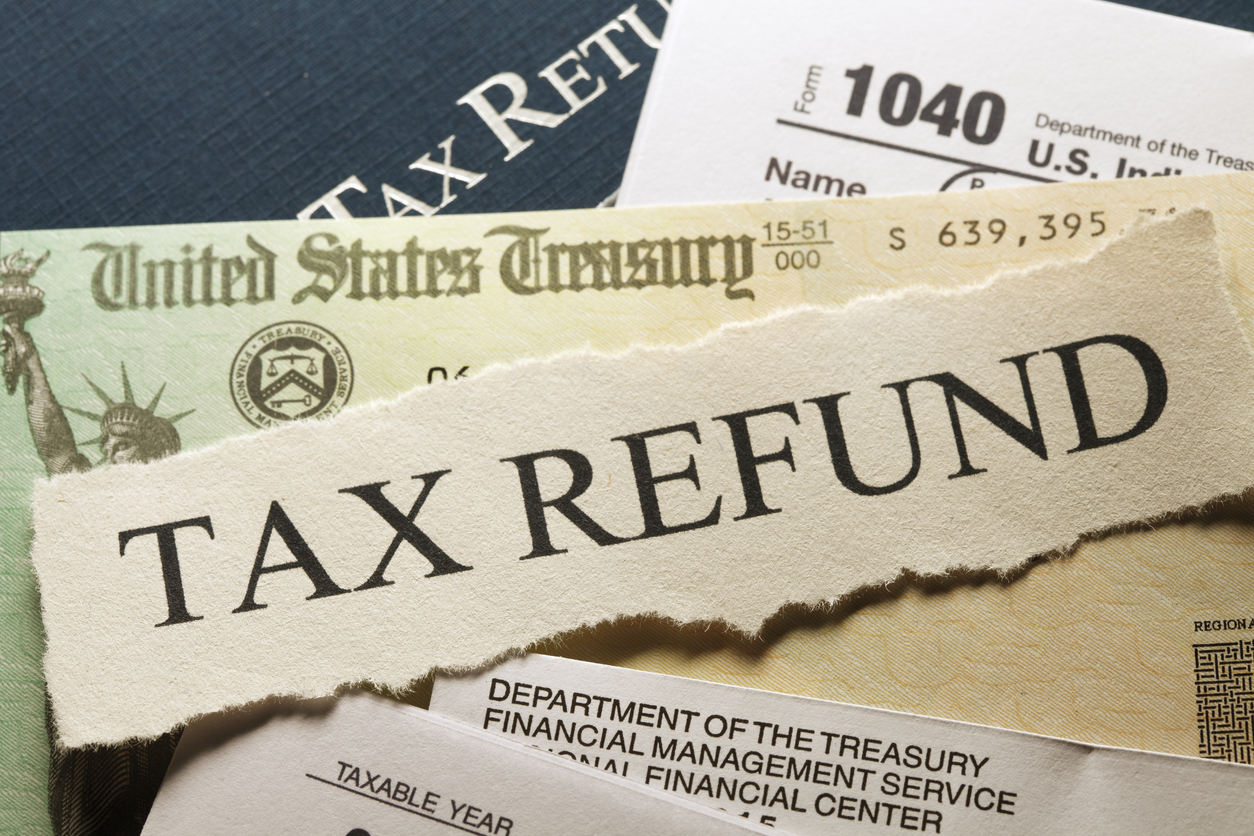
Last Updated on May 5, 2025 by KashKick Crew
A windfall like a tax refund can be a serious boon to your investment plan. If you’re not counting on your refund to pay bills or eliminate high-interest debt, investing it is a smart way to turn that extra paycheck into even more money.
Spending your refund on a treat like a major purchase or a vacation can be a fun way to use it, too. And maybe some years, that’s just what you need. But if you’ve been trying to prioritize your long-term savings for a while and never feel like you can afford it, your tax refund is a great way to make it happen.
Investing Apps for Your Tax Refund
Investment apps make it simple to start investing when you don’t have a ton of money to spare (or to spend on a pricy advisor). Your tax refund is a great start to your nest egg, and you can use these apps to contribute a little bit each week to keep your savings growing:
- Acorns: Did you know you can literally invest your spare change? Acorns rounds up purchases on your debit and credit cards and sticks the extra in an investment portfolio based on your goals. Portfolios include a balance of companies, markets, bonds and, if you want, Bitcoin, in exchange-traded funds (ETFs).
- Public: Invest like a Wall Street pro with Public’s market insights and income forecasts in your dashboard. You can trade pieces of individual stocks right from your phone, or schedule recurring contributions into a personalized investment plan of your choice for stocks, ETFs and crypto.
- MooMoo: Seasoned investors can grow savings on the go with Moomoo, which is designed for active trading. If you’re already familiar with terms like “options,” “fractional shares” and “cash sweep,” this app is for you.
- Robinhood: The OG microinvesting app is still one of the most popular among beginners and experienced traders alike. Robinhood lets you buy pieces of stocks for as little as $1 — and it even gives you a free stock when you sign up!
- Streetbeat: Chatting with Streetbeat’s AI investment advisor is just like talking with a human advisor. Tell it your goals or the types of companies you want to invest in and it’ll set you up with a personalized portfolio with timely updates and rebalancing.
- SoLo Funds: Lend money to a person in need and earn a return in the form of a “tip.” Through SoLo Funds, borrowers set the terms, and you can choose which micro-loans to make based on the tip amount, the loan’s purpose and the borrower’s reputation in the app.
- Fundrise: Invest in real estate without the hassle of managing property! Fundrise lets you add real estate to your portfolio by investing in real estate investment trusts (REITs), so you can diversify your investments, grow your money passively and build wealth without the headaches of being a landlord.

Tips to Invest Like a Pro
As you get started on your investment journey, follow these tips to set goals, understand your options and make a sustainable plan for your financial future.
1. Set Clear Investment Goals
Every journey needs a map, and your financial journey is no exception! Financial goals should support the personal milestones you want to hit throughout your life — and they have to be realistic. Follow these tips to set sustainable financial goals:
- Define the purpose of your investments. Make sure you know what you want to achieve with your investments. Is this your main retirement plan, extra long-term savings, or for a shorter-term goal like buying a car or making a down payment on a house?
- Get specific. Give your goals some details. Instead of “I want to save for a car,” set a goal like “I want to save $40,000 to buy a car 12 months from now.” Consider the SMART system for goal-setting: specific (details, like what is this money for?); measurable (set a target number so you know when you’ve reached it); achievable (it should align with your resources!); relevant (save for something you actually want); and time-bound (what’s your deadline?).
- Consider your timeline. Called your “time horizon” in investor-speak, this determines what kinds of things you’ll invest in. For example, a long time horizon, like retirement 30 years from now, leaves room for ups and downs, so you can make riskier investments. For a shorter horizon, like buying a house in two years, you’d want more stable investments, like bonds or CDS.
- Do some math. An investment calculator can help you figure out how much to invest each month to reach your goals. Returns aren’t guaranteed, but figuring out a conservative estimate can at least give you a plan to follow.
- Embrace diversity. A diversified investment portfolio is your armor against volatility in the market. Invest in an index fund or index-tracking ETF to easily spread your investments across a variety of companies and industries. Or choose stocks and bonds industries to reduce your risk of losing big if any one industry gets rocky.
- Review and adjust regularly — but don’t panic! Use an app to review your investment goals and progress about every quarter and adjust your automated investments. But don’t panic and make huge changes based on stock market headlines. If you’re unsure about your investment priorities or progress, hire a Certified Financial Planner to help adjust your plan.
2. Understand Your Investment Options
From stocks to bonds to real estate, the investment world is your oyster! Let’s explore some options for your investments:
- Stocks: Also known as shares or equity, stocks are the most common type of investment. They represent ownership in a company. Through investment apps, you can purchase full stocks or a piece of a stock called a “fractional share.”
- Bonds: Lend money to a borrower for a defined period with an interest rate. You can buy bonds from private companies, called corporate bonds; or governments, called Treasury bonds from the U.S. federal government.
- Mutual funds: This is a pool of money gathered from multiple investors to be invested in stocks, bonds and other assets. A professional firm chooses what to invest in, and investors own shares of the whole fund. This is an easy way to diversify your investments. Index funds — mutual funds that track the performance of a stock index like S&P 500 — are some of the most stable and most recommended investments.
- Exchange-traded funds (ETFs): ETFs are like mutual funds in makeup, but you can purchase your share of the fund on the market like you can a stock. You don’t have to go directly to the firm managing the fund. ETFs are popular on investment apps, because they let you have control while diversifying, without the chore of choosing individual stocks.
- Real estate: You can invest in residential and commercial property without having hundreds of thousands of dollars to start. Invest through a real estate investment trust (REIT) with just a few hundred dollars to get a piece of the action!
Check out our Beginner’s Guide to Investing to learn more ways to invest.
3. Stay in It for the Long Haul
Investment pros know about the magic of “compounding” — the ability of investments to grow faster and faster over time. That happens because the money you earn on investments gets reinvested back into the market, where it can also earn more. So you earn on your initial investment plus on the gains from that investment, without putting in more money.
Compounding is the financial world’s “snowball.”
This effect works best over the long term, when you can let your initial investment have time to grow and reinvest… and grow and reinvest… and grow and reinvest… you get you.
For the average investor, investments are meant for long-term savings, like retirement. Once you put your money in, let it hang out in your portfolio and do its thing so you can benefit from compound returns.
4. Avoid Investment Pitfalls
Investing always comes with some risk — if your shares become worth less than what you paid for them, your portfolio loses value. Ups and downs are normal throughout the life of an investment portfolio, so follow these tips for the best chance to come out ahead in the end.
- Acting like a day trader. Everyday investors usually have a similar goal: building savings. So it doesn’t help you to follow the advice of people who are trying to outsmart the market and make a quick buck. Do your research so you understand the basics behind your investments — including types of securities, fees and commission rates, and when and how you get paid. But don’t get caught up trading individual stocks trying to chase the next trend — that’s a high-risk game even the pros lose most of the time.
- Putting all your eggs in one basket. Don’t invest all of your money into a single company or even a single industry (like tech or crypto). That leaves you open to losing everything if disaster strikes that company or industry (think: dot-com bust). Spread out your stock picks across industries, and make sure your portfolio also includes stabler investments like bonds and real estate. An easy way to diversify is to purchase shares of mutual funds or ETFs.
- Chasing past performances. Say it with us: Past performance does not guarantee future results. That’s the mantra of the investment world. Just because lightning strikes and a stock’s value spikes one year doesn’t mean it’ll happen again. Don’t gamble your investments based on past hits; put your money into tried-and-true, diversified funds.
- Pulling out when the market dips. Many investors panic over headlines about the stock market plummeting for a single day or week because of current events. But this isn’t 1929. The market has reliably trended upward for decades. You have to ride out market waves to benefit from returns in the long run. Plus, selling when values are down is a surefire way to lose money now or miss out on future returns! (Caveat: If you’re planning to need the money in the next three to five years, work with a financial advisor to move your money into less risky investments to protect against market dips.)
From Refund to Riches!
Investing a tax refund is a great way to jump-start your long-term savings. Set smart goals, review your options and avoid tempting investment pitfalls, and you can set your money up to work for you for many years to come.
